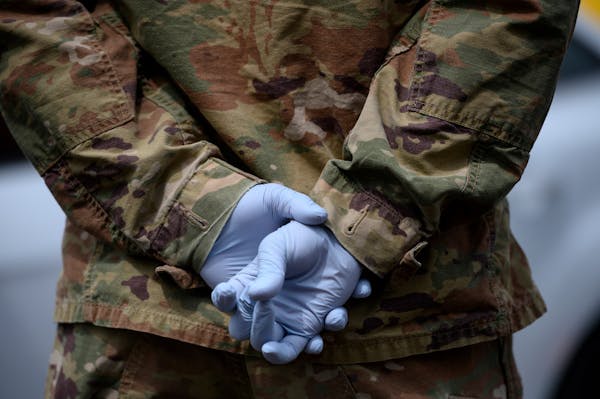Minnesota's COVID-19 testing capacity will significantly expand next week with the opening of a processing facility that can analyze up to 30,000 saliva samples per day to detect the coronavirus that causes the infectious disease.
The lab in Oakdale and three new sample collection sites will hasten the detection of COVID-19 hot spots in Minnesota and result in faster quarantines and protective measures to snuff out the spread of the virus, Gov. Tim Walz said.
"The longer it takes for us to find out if somebody has this, the more they unknowingly spread it," Walz said on Tuesday. "So taking a test and waiting several days to get the results, that really impedes our ability to slow this down."
COVID-19 tests using saliva samples are a relatively new innovation amid the pandemic — with the original molecular diagnostic tests analyzing nasal or throat swab samples that are harder to collect.
"The swabs went all the way to your brain, it felt like for many people," Walz said.
Minnesota bet big on the new technology through a $14.6 million partnership with Rutgers University and Infinite Biologics in New Jersey and until now had been analyzing saliva samples collected at a free testing site in Duluth.
More than 8,000 samples have been collected at the site. New sites are being added in the next week in Winona, Moorhead and Brooklyn Park.
Ten sites statewide are planned, and Minnesota plans to test a mail-order saliva test kit approach starting next month, said Dan Huff, assistant state health commissioner.
Insurance will be billed for those with coverage, but individuals will not have to bear any cost, he added. "We will bill insurance; however, if you are uninsured or underinsured, you will not receive a bill."
Samples will be delivered to the new in-state facility, which will speed up turnaround time, expected to be 48 hours.
The testing expansion comes amid signs of a new COVID-19 peak in Minnesota, which on Tuesday reported seven COVID-19 deaths and 1,150 infections — bringing the state totals to 2,151 deaths and 114,574 infections.
The rate of infection that couldn't be traced back to specific sources in communities is now 38%, indicating that the virus is spreading beyond the state's ability to track it and contain it.
Minnesota has increased diagnostic testing by 65% since early September, Huff said. That has produced a comparable increase in confirmed infections — including some people with mild or no symptoms who might have otherwise gone undetected.
Critics of Minnesota's COVID-19 response strategy worry that even more testing will fuel higher infection counts, which will then be used as a reason for more restrictions or closures of schools or businesses. Minnesota already advises schools based on their recent county COVID-19 infection rates — with only five counties having low enough rates to advise all in-person learning.
Huff urged people to remember that the goal "is to protect life and it's to protect health of all Minnesotans ... Testing allows us to do that. If I am infected, I need to know that so I can protect others who might be more vulnerable."
Walz said increased testing won't distort the state's pandemic response and that many school reopening decisions are based more on local realities, such as whether hallways and classrooms are big enough to maintain social distancing, than on case counts.
The governor ordered a 51-day statewide lockdown this spring to buy time for Minnesota hospitals to prepare and add critical care supplies and personal protective equipment. However, he agreed with a recent assessment by a World Health Organization executive that lockdowns cannot be used as a long-term strategy because of the economic harm and the stress on individuals.
"It's not sustainable to keep people locked down," he said.
Walz has previously said that he is closely watching two statistical indicators, including the unknown community transmission rate and the positivity rate of diagnostic testing — which is now at the state's caution threshold of 5%. Neither statistic is as easily swayed by changes in testing activity as the daily infection numbers.
Hospital capacity also remains a key concern, with the state reporting that 70% of Minnesota's immediately available intensive care unit beds are filled with patients who have COVID-19 or other medical problems.
The state reported on Tuesday that 481 COVID-19 patients were admitted to Minnesota hospitals, and that 134 needed intensive care because of breathing problems or other complications from their infections. COVID-19 hospital numbers have been rising since late September.
Specimens from saliva or nasal swabs are analyzed through the same PCR test methodology, which breaks them down into genetic components and then tries to reproduce RNA strands of the coronavirus that causes COVID-19.
Accuracy of the new saliva collection method remains a concern. A rival saliva testing platform developed at Yale University showed 94% agreement when validated against PCR tests that used nasal swabs. A Canadian study found COVID-19 in 70 of 1,939 high-risk individuals whose saliva and nasal samples were tested. But in 22 of those cases, only one sample produced a positive.
Jeremy Olson • 612-673-7744

Want to share info with the Star Tribune? How to do it securely

'Safe recovery sites' would offer syringes, naloxone and more to people using drugs. The plan could be in peril.
New Minnesota GOP leaders seek peace with party's anti-establishment wing

Who is Republican Lisa Demuth, Minnesota's first House speaker of color?

